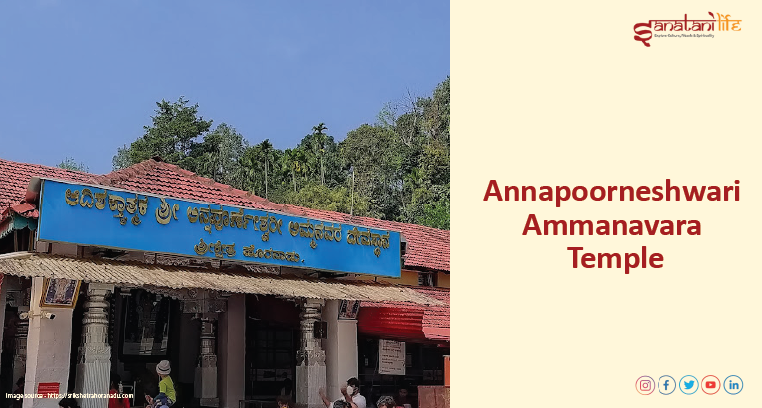Adhishakthyathmaka Sri Annapoorneshwari Ammanavara Temple
The Adhishakthyathmaka Sri Annapoorneshwari Ammanavara Temple is one of the most respected spiritual sites in South India, and it is tucked away amid the beautiful Karnataka landscapes. Goddess Annapoorneshwari, a manifestation of Goddess Parvati, is worshipped at this temple. She represents the divine sustenance of all living things as well as food and plenty. The word “Annapoorneshwari” comes from Sanskrit, where “Anna” denotes food or nourishment and “Purna” represents fullness or wholeness. In addition to being a place of spiritual refuge for followers, the temple serves as a ray of hope for people looking for heavenly favours related to wealth, health, and happiness.
Thank you for reading this post, don't forget to subscribe!History of Annapoorneshwari Temple
Ancient Hindu mythology and customs are at the heart of the Adhishakthyathmaka Sri Annapoorneshwari Ammanavara Temple’s heritage. The temple is thought to have been built in honour of Goddess Annapoorneshwari, who is regarded as the goddess of wealth and sustenance. The temple’s history spans several centuries, and pious rulers, sages, and followers have upheld its holiness throughout time.
- In Hindu mythology, the city of Kashi (Varanasi) is strongly linked to the tale of the goddess Annapoorneshwari. According to legend, Lord Shiva reportedly said that food is a component of the illusion that is the world, or Maya.
- Goddess Parvati manifested as Annapoorneshwari and fed the people of Kashi to teach him the value of nutrition, demonstrating that food is necessary for both life and spiritual development. Her deed proved that spiritual enlightenment and material life are intertwined, with nutrition serving as a heavenly gift that nourishes the body and the spirit.
- The construction of the Adhishakthyathmaka Sri Annapoorneshwari Ammanavara Temple was motivated by this heavenly tale and serves as evidence of the goddess’ kindness and generosity. Devotees from all over the world came to the temple as it developed into a hub of faith, seeking blessings for health, wealth, and the ability to overcome obstacles in life.
- Its historical significance is also reflected in the temple’s architecture and traditions. According to ancient texts and inscriptions discovered nearby, the temple has long been a place of pilgrimage and prayer. Its position as a hallowed site has been further enhanced by its affiliation with Vedic traditions and its function in advancing the practice of annadana.
- The Adhishakthyathmaka Sri Annapoorneshwari Ammanavara Temple is a timeless emblem of faith and divine abundance that has inspired devotion and veneration throughout its rich history and ongoing spiritual importance.
The Significance of Sri Annapoorneshwari Ammanavara Temple
For devotees, the Sri Annapoorneshwari Ammanavara Temple is extremely significant both spiritually and culturally. The temple is devoted to Goddess Annapoorneshwari, the goddess of plenty and sustenance, and symbolizes the divine source of food for all living things. “Anna,” which means nourishment, and “Poorneshwari,” which means the one who fills or satisfies, are the Sanskrit terms from which the very name “Annapoorneshwari” springs. This illustrates the goddess’ everlasting function as the giver of sustenance, wealth, and happiness.
The Goddess Annapoorneshwari’s Divine Role
- Food is regarded as one of the most important needs for both survival and spiritual development in Hindu philosophy.
- The goddess Annapoorneshwari represents the heavenly quality of food and its vital function in nourishing the body and the spirit.
- She is said to be an incarnation of Goddess Parvati, who manifested as Annapoorneshwari to teach humanity the value of sustenance, according to ancient Hindu texts.
- Devotees adore and worship her as a divinity because of her presence at the temple, which symbolizes compassion, plenty, and the sustaining of life.
The emphasis on Annadana
- As one of the highest acts of generosity in Hinduism, annadana, or the donation of food, is highly valued at the temple. Annadana, which reflects the goddess’s divine essence, is considered a sacred act of selflessness and devotion to humanity.
- Every day, hundreds of devotees at the Sri Annapoorneshwari Ammanavara shrine receive complimentary meals, guaranteeing that none leaves the shrine hungry.
- In addition to meeting guests’ urgent physical needs, this practice upholds the spiritual values of appreciation and sharing.
- Many followers think that by taking part in or contributing to the temple’s annadana, they are inviting the goddess’ blessings, which will guarantee them wealth, health, and harmony in their lives.
- Because of this custom, the temple has come to represent the generosity of God and a haven for the needy.
Realizing Dreams and Overcoming Adversities
- When devotees visit the temple, they frequently pray to Goddess Annapoorneshwari for help overcoming obstacles in their lives, whether they be monetary, health, or personal.
- Her blessings are thought to be able to clear the path, give support when things get hard, and result in the realization of deep-seated wishes.
- The reputation of the goddess as a kind and kind divinity is further cemented by the numerous testimonies of miracles and benefits shared by temple visitors.
- Additionally, the temple is said to be a location for spiritual healing.
- When pilgrims worship the goddess, they frequently describe feeling incredibly calm and strong inside.
- Hope, thankfulness, and devotion are sparked by the temple’s uplifting atmosphere and heavenly presence.
Spreading Spiritual Knowledge
- In addition to being a place of worship, the temple is a hub for disseminating spiritual knowledge and the value of being thankful for all that life has to offer.
- The temple teaches its followers about the value of compassion, the interconnectivity of all beings, and the sanctity of food via its festivals, poojas, and everyday rituals.
- True spiritual development starts with selflessness, appreciation, and the realization that food is a gift from God, according to the traditions and teachings connected to Goddess Annapoorneshwari.
Architecture of Adhishakthyathmaka Sri Annapoorneshwari Ammanavara Temple
A stunning example of traditional South Indian temple construction, the Adhishakthyathmaka Sri Annapoorneshwari Ammanavara Temple combines exquisite beauty with deep spiritual connotations. From the sanctum sanctorum to its imposing gopurams (gateway towers), every aspect of its architecture demonstrates commitment, skill, and adherence to Vedic architectural ideals.
Layout of the Temple
The temple’s pyramid-shaped towers, elaborate carvings, and symmetrical designs are hallmarks of its Dravidian architectural style. Devotees are encouraged to set off on a journey of inner calm and divine connection through the tranquil and spiritually charged ambience created by the entire building.
- Entrance Gopuram: The temple’s ornately carved gopuram, or entrance tower, serves as a magnificent entryway to the hallowed grounds. The elaborate carvings of gods, goddesses, mythical scenes, and floral patterns that adorn the gopuram represent the sacred stories found in Hindu texts. Visible from afar, this imposing building serves as a light of holiness, directing travellers toward the temple.
- Temple Courtyard: The huge courtyard is a peaceful space that can hold a lot of worshippers. There are ornamental pillars, shady rest spots, and stone walkways all along it. The deepastambha, or light tower, in the courtyard,d is frequently lit during festivals and other events, enhancing the temple’s heavenly ambience.
Garbhagriha, or Sanctum Sanctorum,
- Made from a precious black stone, the idol of Goddess Annapoorneshwari represents power, purity, and divinity.
- With a ladle in one hand and a pot of food in the other, the goddess is beautifully shown in her charitable guise, symbolizing her everlasting function as humanity’s nourisher.
- Her calm demeanour radiates kindness and elegance, providing comfort to everyone in her presence.
- Traditional oil lamps are the main source of the garbhagriha’s modest lighting, which gives the deity a gentle, flickering glow.
Mandapa (Hall of Prayer)
- Several intricately carved stone pillars, each a work of art, support the mandapa. These pillars create awe-inspiring surroundings with their elaborate decorations that portray mythological themes, heavenly creatures, and divine symbols. Because they depict the cosmic order and the interdependence of all creation, the sculptures have spiritual meaning in addition to being just ornamental.
- With its elaborate patterns of lotuses, mandalas, and other geometric decorations, the mandapa’s ceiling is equally impressive. The lotus, a symbol of innocence and enlightenment, takes centre stage in the artwork, highlighting the room’s hallowed function.
Beauty in Sculpture
- With its representations of gods, sages, cosmic conflicts, and heavenly interventions, these relief sculptures are a visual celebration of Hindu mythology.
- With its elaborate reliefs of gods like Ganesha, Vishnu, and Shiva as well as celestial creatures like apsaras (heavenly dancers) and Gandharvas (heavenly musicians), the outside walls are particularly remarkable.
- Sacred creatures that stand for strength, protection, and wealth, such as cows, lions, and elephants, are also frequently depicted.
The Vimana
- The vimana is frequently painted in vivid hues or adorned with gold, giving it the temple’s main visual attraction. The levels in its design symbolize several worlds and the path to heavenly enlightenment, combining spiritual symbolism with aesthetic refinement.
- A kalasham, a golden pot-like structure that represents riches and the heavenly benefits that pour down from the skies, sits at the top of the vimana.
- In addition to adding to the temple’s architectural magnificence, the vimana acts as a spiritual lighthouse that draws followers nearer to God.
Temple Tank
- Before entering the temple, devotees frequently bathe in or mist the water from the tank as part of a ritual cleaning.
- Because water from the tank is utilized in many poojas and rituals, it also plays an important part in temple celebrations.
- The tank’s significance as a holy location is further reinforced during festivals when it serves as a venue for special festivities and community meetings.
Rituals of Sri Annapoorneshwari Ammanavara Temple
Rooted in Vedic traditions and devotional practices, the Sri Annapoorneshwari Ammanavara Temple is well known for its profoundly symbolic and spiritually uplifting rites. Every devotee is guaranteed to feel the heavenly presence of Goddess Annapoorneshwari via the careful performance of these rituals on a daily and special occasion basis.
Daily Rituals
1. Suprabhata Seva:
- This ceremony, which is meant to awaken the god, kicks off the day in the temple.
- To begin the day, hymns and chants are recited in honour of the goddess, calling out her blessings and heavenly energies.
- As the priests and devotees take part in this gentle waking process, which marks the start of a new day full of heavenly favour, the atmosphere is one of devotion.
2. Abhisheka (Ritual Bathing):
- Following Suprabhata Seva, the goddess’ idol is ceremoniously washed with holy liquids like as milk, honey, coconut water, ghee, and sandalwood paste.
- This is known as abhisheka or ritual bathing. Abhisheka is a ceremony that cleanses the god and represents the removal of both spiritual and physical impurities.
- Vedic hymns and mantras accompany the bathing rite, adding to its spiritual importance.
3. Alankara (Decorating the Idol):
- The idol of Goddess Annapoorneshwari is exquisitely embellished with new garlands, silk sarees, and jewellery after the Abhisheka.
- Alankara, the adornment, is a sign of regard and devotion. The goddess is depicted wearing colourful garments that change every day to symbolize her many heavenly guises and attributes.
4. Individual Prayers, or Archana:
- The temple priests lead a customized prayer service that devotees can partake in.
- To invoke the goddess’ blessings for the devotee’s health, wealth, and spiritual development, the priest recites the devotee’s name, ancestry, and particular desires.
5. Annadana Seva:
- The giving away of free meals to devotees and guests is one of the temple’s most important daily rites.
- The fundamental teaching of Goddess Annapoorneshwari as the giver of wealth and nourishment is reflected in this activity.
- A communal dining hall serves lovingly made and devotedly cooked meals, signifying equality, solidarity, and the sharing of God’s bounty.
Special Rituals on Auspicious Days
- The temple honours the goddess and asks for her heavenly favours by holding large poojas and homes (fire ceremonies) at significant events and festivals. There are two noteworthy ceremonies:
- The purpose of Navagraha Homa is to eliminate any obstructions brought about by unfavourable planetary alignments and to placate the nine planetary deities.
- Chandika Homa: This potent fire ceremony honours the goddess’s fiery side and is said to provide protection, wealth, and spiritual strength.
Festivals at Annapoorneshwari Ammanavara Temple
Festivals, which are celebrated with majesty, devotion, and community involvement, are when the Sri Annapoorneshwari Ammanavara Temple is most lively. These celebrations highlight the temple’s rich spiritual and cultural legacy in addition to honouring the goddess.
Festival of Navaratri: Navaratri, a nine-day festival honouring the goddess, is one of the temple’s most important events. At the time of Navaratri:
- Daily Rituals and Special Alankara: The goddess is represented by different garments and decorations every day, which represent her many divine guises, including Durga, Lakshmi, and Saraswati. The temple is filled with special poojas and Vedic hymns, which foster a spirit of celebration and dedication.
- Cultural Programs: Highlighting India’s creative and spiritual traditions, the festival features storytelling sessions, recitations of texts, and performances of classical music and dance.
- Community Celebrations: During this holy time, large groups of devotees join in annadana, which represents solidarity and sharing.
The Festival of Lights, or Deepavali: During Deepavali, the temple is exquisitely decorated to represent the triumph of light over darkness.
- Numerous oil lights illuminate the temple grounds, producing a captivating scene that heightens the spiritual atmosphere.
- In keeping with the festival’s themes of joy and plenty, special poojas are conducted to call forth blessings for wealth and pleasure.
- Devotees from all over the world go to the Annapoorneshwari Temple for Deepavali, a visual and spiritual feast.
Makara Sankranti: Makara Sankranti, which is observed during the harvest season, is very significant to the temple.
- As a token of appreciation for a plentiful harvest, devotees present the goddess with fresh vegetables, grains, and other harvest-related objects.
- To obtain the goddess’ blessings for agricultural success and overall well-being, certain rites and annadana are performed.
Akshaya Tritiya: The Sri Annapoorneshwari Ammanavara Temple celebrates Akshaya Tritiya, one of the most important days in the Hindu calendar.
- As the ultimate source of sustenance and wealth, Goddess Annapoorneshwari is honored at the temple with specific poojas and Abhisheka ceremonies.
- To express their thanks and ask for her blessings for endless wealth in their life, devotees present her with goods like rice, grains, fruits, and gold.
How to Reach Annapoorneshwari Temple
Situated in the serene state of Karnataka, the Sri Annapoorneshwari Ammanavara Temple is encircled by verdant surroundings. Dharmasthala, the closest large city, has excellent road connections. To get to the temple, visitors have the option of using buses, taxis, or private automobiles. Travellers from all around the nation may easily reach Mangalore, which is about 100 kilometres distant from the nearest train station and airport. Kempegowda International Airport in Bengaluru provides a practical link for visitors from abroad, followed by a picturesque drive.
Famous Temples In the vicinity of Dharmasthala
When pilgrims visit the Annapoorneshwari Temple, they frequently continue on to other holy sites in the area. Among the most well-known temples are:
- Famous for its Shiva deity and Ananadana customs is Dharmasthala Manjunatha Temple.
- The Kukke Subramanya Temple is devoted to the serpent-protecting Lord Subramanya.
- Adi Shankaracharya founded the historic Advaita Vedanta monastery known as Sringeri Sharada Peetham.
- Another well-known temple to the goddess of sustenance is Horanadu Annapoorneshwari Temple.
- These temples provide believers with a thorough understanding of Karnataka’s heavenly legacy, forming a circuit that enriches their spiritual lives.
The dress code for Darsan
It is recommended that devotees dress accordingly. Male visitors to the temple should ideally cover their shoulders with a shawl or towel rather than covering their chest with clothing.
Timings for Adhishakthyathmaka Sri Annapoorneshwari Ammanavara Temple
Morning: 6:00 AM to 2:00 PM
Evening: 4:00 PM to 9:00 PM
Daily Rituals:
- Suprabhata Seva (Morning Invocation): 6:00 AM
- Abhisheka (Ritual Bathing): 6:30 AM – 8:00 AM
- Alankara (Decorating the Deity): 8:00 AM – 8:30 AM
- Morning Archana (Special Prayers): 8:30 AM – 12:00 PM
- Annadana Seva (Free Meal Service): 12:00 PM – 2:00 PM
- Evening Archana and Pooja: 5:00 PM – 8:30 PM
FAQs regarding Adhishakthyathmaka Sri Annapoorneshwari Ammanavara Temple
Q. What distinguishes Goddess Annapoorneshwari from other Hindu goddesses?
ANS: The goddess Annapoorneshwari, who represents the unbreakable bond between spiritual development and material sustenance, is worshipped as the divine supplier of aliment. She stands out among Hindu goddesses because she is a living example of kindness and giving.
Q. How does the temple incorporate long-standing customs into its day-to-day operations?
ANS: The temple blends contemporary devotional activities like Annadana with traditional Vedic rites like Suprabhata Seva, Abhisheka, and Alankara. This preserves the temple’s cultural legacy while guaranteeing a comprehensive spiritual experience.
Q. Why does the temple view Annadana as a hallowed act?
ANS: The act of giving food, or anandadana, symbolizes the goddess’s divine nature as the source of life. It is seen as a holy act of dedication and selflessness that calls forth blessings for peace, wealth, and good health.
Q. What aspects of the architecture make this temple an essential stop?
ANS: The temple is a spiritual treasure and architectural wonder because of its Dravidian-style architecture, which includes elaborately carved gopurams, a lavishly decorated sanctum sanctorum, and a mandapa held up by carved stone pillars.
Q. During festivals, how does the temple honour spiritual and cultural diversity?
ANS: Special poojas, cultural performances, and community get-togethers are held to commemorate festivals like Navaratri, Deepavali, and Makara Sankranti, which emphasize both spiritual devotion and cultural legacy.
Q. What may worshippers anticipate from the temple’s spiritual atmosphere?
ANS: With oil lights, Vedic songs, and an abundance of greenery, the temple provides a serene setting that helps followers feel deeply at peace and connected to God.






